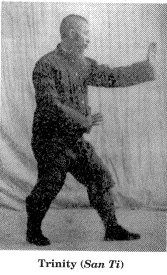Julius Skrrvin
I be winkin' through the scope
Ima talk about the philosophy of my system. I'm studying Sun-style Xingyiquan, which is heavily based off Daoist principles (as are the other two main internal/neijia styles = Taijiquan or Tai Chi Chuan and Baguazhang). Xingyiquan means "Form-Mind" boxing. The martial art is separated into an external and internal component. The Form or Xing, is the external movement and shape of your attacks, physical strength. The internal component involves the training and focus of the spirit, intention, coordination/neural aspects, and the creation of intenal strength through neigong.
Before training, there is no thought, no intention. Only Qi exists in the chaos of the body. This state of emptiness is Wu Ji. Before boxing, one must be empty. Nothing is in the heart (emotion), no motives in the eyes or power in the eyes. No intention. Here the Qi then moves from emptiness to Tai Ji, or the state of changing Qi. the body begins to move, and the mind begins to contemplate the union of heart, force, and qi. From there we move to Liang Yi, the act of moving and stretching and contracting. Here our external fighting stance takes place and we begin to manifest the Six Harmonies of the body that ensure the generation of coordinated strength and stability. At this point, we have reached the trinity, or San Ti Shi. Here is a picture of my style's founder in the stance:

this stance represents the marriage of heaven, earth and the human being. standing practice in this builds a powerful root, and prepares the body to create energy, turning the human essence (jing) into Qi. The stance should be relaxed, yet strong and stable. The intention should be expanding, listening internally to the body, focused on the dan tian or navel area.
The six harmonies (Liu He) are essential:
1)The hands harmonize with the feet,
2)The shoulders harmonize with the hips,
3)The elbows harmonize with the knees,
4)The heart harmonizes with the intent,
5)The intent harmonizes with the qi,
6)The qi harmonizes with the power.
Thats the most basic foundation of xingyi practice from an internal and external standpoint, and includes the philosophical basis of the form and principles. There is much more, but that is the basic.
Before training, there is no thought, no intention. Only Qi exists in the chaos of the body. This state of emptiness is Wu Ji. Before boxing, one must be empty. Nothing is in the heart (emotion), no motives in the eyes or power in the eyes. No intention. Here the Qi then moves from emptiness to Tai Ji, or the state of changing Qi. the body begins to move, and the mind begins to contemplate the union of heart, force, and qi. From there we move to Liang Yi, the act of moving and stretching and contracting. Here our external fighting stance takes place and we begin to manifest the Six Harmonies of the body that ensure the generation of coordinated strength and stability. At this point, we have reached the trinity, or San Ti Shi. Here is a picture of my style's founder in the stance:

this stance represents the marriage of heaven, earth and the human being. standing practice in this builds a powerful root, and prepares the body to create energy, turning the human essence (jing) into Qi. The stance should be relaxed, yet strong and stable. The intention should be expanding, listening internally to the body, focused on the dan tian or navel area.
The six harmonies (Liu He) are essential:
1)The hands harmonize with the feet,
2)The shoulders harmonize with the hips,
3)The elbows harmonize with the knees,
4)The heart harmonizes with the intent,
5)The intent harmonizes with the qi,
6)The qi harmonizes with the power.
Thats the most basic foundation of xingyi practice from an internal and external standpoint, and includes the philosophical basis of the form and principles. There is much more, but that is the basic.
 Mixed Martial Arts is a concept that has been around as long as there have been free fighting contests. Pankration, certain types of wrestling, early boxing contests, Chinese Martial Art contests...
Mixed Martial Arts is a concept that has been around as long as there have been free fighting contests. Pankration, certain types of wrestling, early boxing contests, Chinese Martial Art contests...